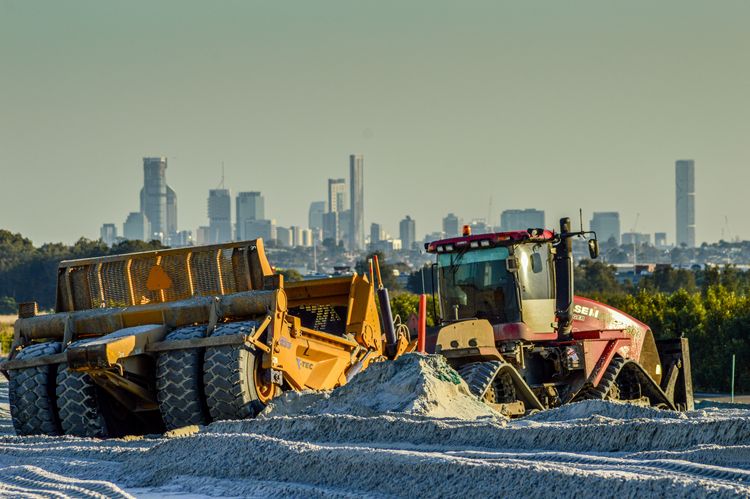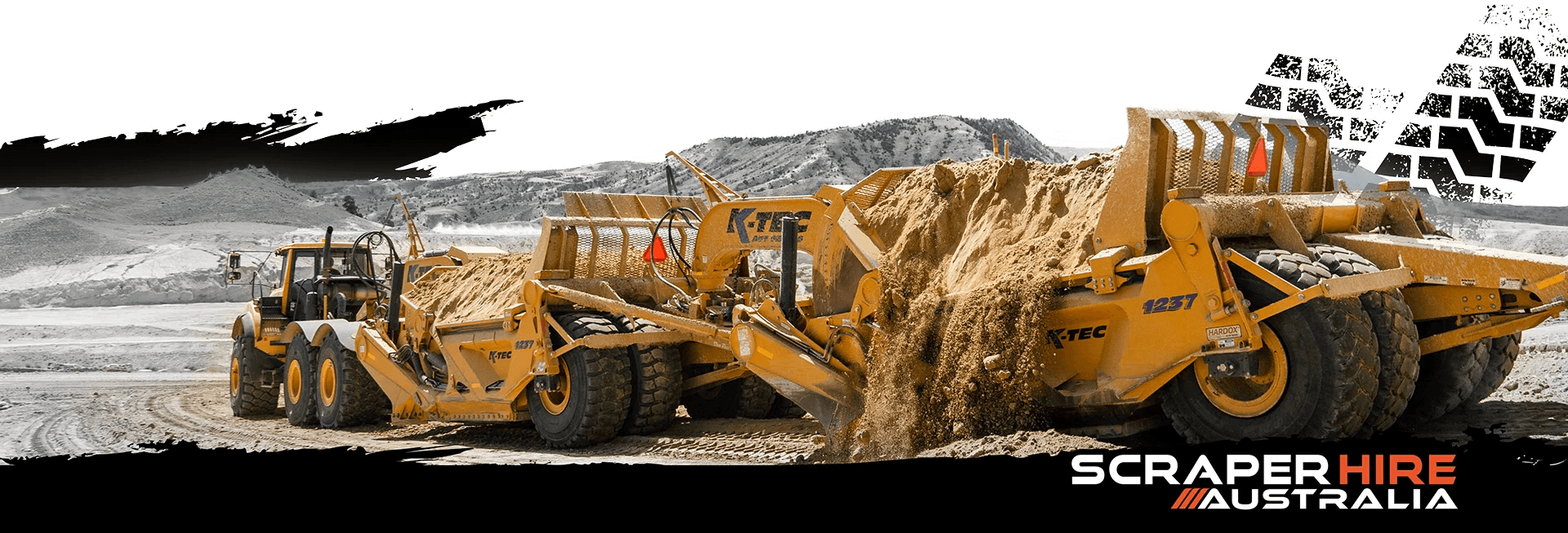n the grand tapestry of human progress, few elements have played as pivotal a role as the ability to shape and manipulate the Earth’s surface. From the creation of civilizations to the development of modern infrastructure, the art of earthmoving has been the bedrock upon which societies have flourished. At the heart of this transformative process lies the unsung hero of construction and mining: the earthmoving scraper. In this exploration, we journey through time to unearth the captivating history and evolution of earthmoving scrapers, revealing their profound impact on the landscapes that surround us.
Early Foundations: Manual Earthmoving Techniques
Long before the advent of mechanized equipment, the movement of earth was a labor-intensive endeavor that relied solely on human effort. Ancient civilizations used basic tools such as shovels, hoes, and picks to excavate and shape the terrain. These manual techniques, while effective on a small scale, were woefully inadequate for the monumental tasks demanded by large construction and mining projects.
The limitations of manual labor inspired inventors to seek more efficient methods. This quest for innovation would ultimately lead to the development of mechanized earthmoving equipment, marking a significant leap forward in the construction and mining industries.
Steam-Powered Innovation: The Emergence of Mechanized Scrapers
The dawn of the Industrial Revolution brought with it a wave of technological advancements that would forever change the way we interact with our environment. Steam power emerged as a driving force behind mechanization, and it wasn’t long before this transformative energy source found its way into the realm of earthmoving.
Steam-powered machines, including steam shovels and bulldozers, revolutionized excavation practices by replacing manual labor with mechanical power. However, it was the birth of the mechanized scraper that truly heralded a new era of earthmoving efficiency.
During this period, the first mechanized scrapers emerged, equipped with steam-powered engines and innovative design features. These early scrapers had the capacity to cut through soil, gather material, and transport it to desired locations. This marked a significant departure from manual methods, allowing for larger quantities of earth to be moved in a fraction of the time.
From Horse-Drawn to Self-Propelled: Scrapers in the Early 20th Century
The early 20th century witnessed a rapid evolution in scraper design and technology. With the advent of internal combustion engines and improved mechanical systems, scrapers transitioned from being horse-drawn to becoming self-propelled machines. This shift unlocked new levels of mobility and efficiency, enabling scrapers to navigate various terrains with greater ease.
Innovators and manufacturers played a crucial role in refining scraper technology. Engineers like R.G. LeTourneau and Frank G. Hough introduced advancements that enhanced scraper functionality and performance. The introduction of hydraulics further improved the control and precision of scraper operations, setting the stage for the technological leaps that lay ahead.
The Post-War Boom: Modernization and Technological Leap
The aftermath of World War II ushered in an era of rapid industrialization and urbanization. Construction and infrastructure projects surged as nations focused on rebuilding and modernizing their landscapes. Earthmoving scrapers played a pivotal role in these endeavors, shaping the foundations of modern cities and transportation networks.
Technological innovations during this period propelled scraper design and capabilities to new heights. Hydraulic systems became more sophisticated, allowing for greater precision and control during excavation. The introduction of articulated frames and bowl designs further optimized scraper efficiency, enabling them to tackle diverse tasks with unparalleled versatility.
The post-war boom also saw the rise of large-scale infrastructure projects, such as the construction of highways, airports, and dams. Earthmoving scrapers became indispensable tools in these ambitious undertakings, accelerating project timelines and reducing labor costs.
Precision and Automation: Scrapers in the Digital Age
As the world entered the digital age, the evolution of earthmoving scrapers took another remarkable turn. The integration of advanced technologies, such as GPS-guided systems and automation, redefined scraper operations and unlocked new levels of precision and efficiency.
GPS-guided scraper systems revolutionized the way operators interacted with their machines and the terrain. Real-time positioning data enabled operators to follow design plans with unprecedented accuracy, resulting in finely graded surfaces and minimized material waste. Automation further streamlined operations by ensuring consistent and controlled scraper movements, reducing human error and optimizing efficiency.
These technological advancements have not only expedited construction and mining projects but have also significantly reduced the environmental impact of earthmoving operations. Scrapers equipped with GPS technology can work with incredible precision, minimizing unnecessary soil displacement and preserving natural contours.
Environmental Considerations: Eco-Friendly Evolution of Scrapers
As environmental awareness grew, the construction and mining industries faced increasing scrutiny regarding their ecological impact. Traditional earthmoving practices often led to significant soil disruption, erosion, and habitat destruction. Earthmoving scrapers, however, began to embrace eco-friendly innovations, paving the way for more sustainable practices.
Modern scrapers incorporate features designed to minimize their environmental footprint. The precision of GPS-guided systems reduces the need for excessive soil displacement, preserving topsoil and minimizing erosion. Additionally, scraper-assisted restoration efforts have contributed to habitat preservation and ecological revitalization.
The integration of cleaner fuel options and emissions control technologies has further reduced the environmental impact of scraper operations. These advancements align with the global shift towards sustainable development and underline the scraper industry’s commitment to responsible earthmoving.
Cultural and Industrial Impact: Scrapers in Popular Culture and Society
The influence of earthmoving scrapers extends beyond construction sites and mining operations. These machines have left an indelible mark on popular culture, symbolizing progress, transformation, and the reshaping of landscapes.
In literature, scrapers often serve as metaphors for change and reinvention. In films, they make dramatic appearances, symbolizing the immense power and capabilities of modern machinery. Artistic representations of scrapers capture their dynamic and awe-inspiring presence, reflecting their significance in shaping the modern world.
Moreover, the industrial impact of scrapers on urbanization cannot be overstated. These machines have played a crucial role in transforming barren land into thriving cities, enabling the creation of vital infrastructure and public spaces. The towering skyscrapers and intricate road networks that define urban landscapes owe a debt of gratitude to the earthmoving scrapers that laid their foundations.
Looking Ahead: Future Prospects and Technological Advancements
As we stand at the precipice of a new era, the future of earthmoving scrapers is rife with potential and innovation. Advancements in artificial intelligence, robotics, and data analytics hold the promise of further revolutionizing scraper technology.
AI-powered scraper systems can analyze real-time data to optimize scraper movements, fuel consumption, and material transportation. These systems can adapt to changing terrains and conditions, maximizing efficiency and reducing resource wastage. Robotics may lead to the development of autonomous scrapers that can operate with minimal human intervention, enhancing safety and productivity.
Furthermore, the applications of earthmoving scrapers extend beyond construction and mining. Their precision and versatility make them ideal tools for environmental restoration, disaster response, and even extraterrestrial exploration.
Conclusion
The evolution of earthmoving scrapers is a testament to human ingenuity, ambition, and the relentless pursuit of progress. From the labor-intensive methods of ancient civilizations to the precision and automation of the digital age, scrapers have undergone a remarkable journey. Their impact on construction, mining, and society as a whole is immeasurable, shaping the landscapes we inhabit and the cities we call home.
At Scraper Hire Australia, we recognize the historical significance and future potential of earthmoving scrapers. Our state-of-the-art scraper fleet are equipped to deliver efficient and sustainable solutions for your projects. Join us in celebrating the legacy of innovation that earthmoving scrapers represent and experience the transformative power of advanced scraper technology.
Citations and Additional Resources:
- Brodsky, E. (2003). Moving Millions: How Coyote Valley Turned Scraper into Sculptor. University of California Press.
- Golden, D. (1999). The Earthmover Encyclopedia. Motorbooks International.
- Hartman, H. L. (2002). SME Mining Engineering Handbook. Society for Mining, Metallurgy & Exploration.
- Haddock, K. (2017). Earthmovers in Australia: The History of Earthmoving Machinery from Parramatta to Townsville. Rosenberg Publishing.
- Ryder, D. (2000). The Earthmover Encyclopedia. MBI Publishing Company.




